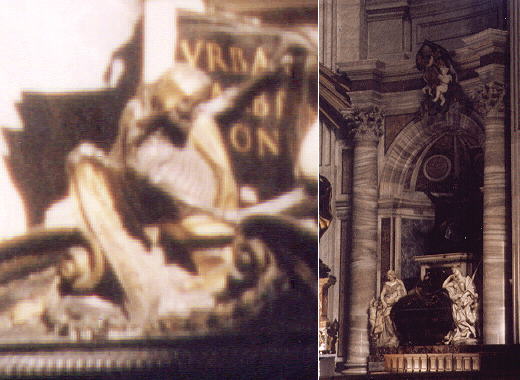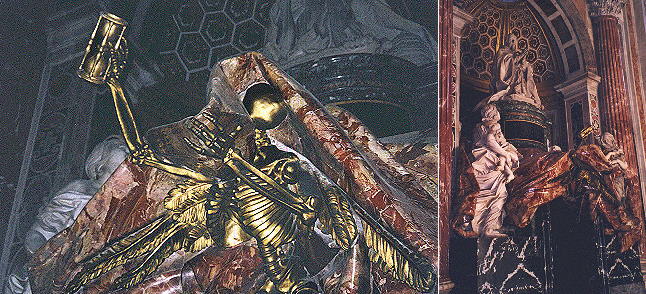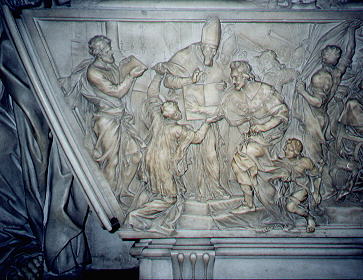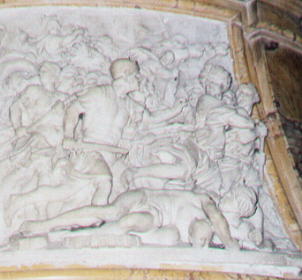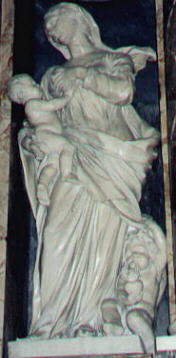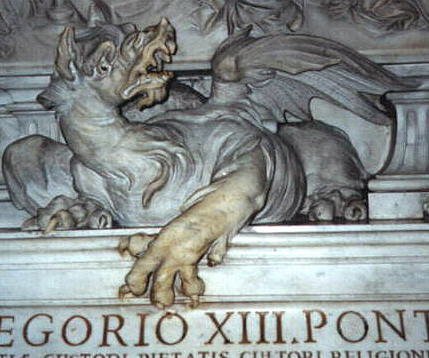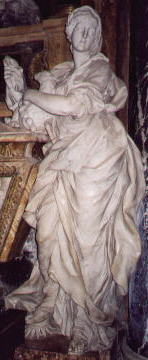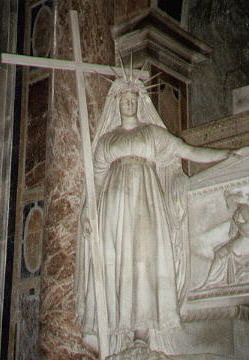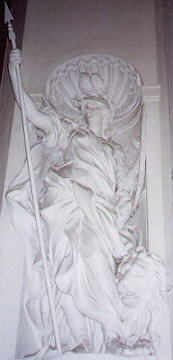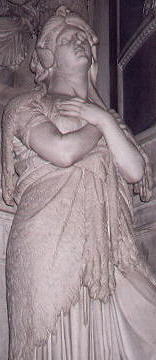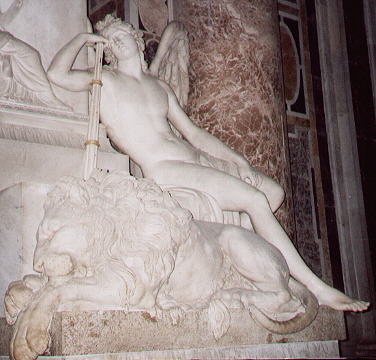  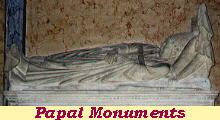 Part two - Baroque and Neoclassical Monuments
Gian Lorenzo Bernini Part two - Baroque and Neoclassical Monuments
Gian Lorenzo BerniniGian Lorenzo Bernini was asked by Urbanus VIII (1623-44) not only to design a monument to him, but to define a pattern
for the monuments to be placed in S. Pietro, which at that time was finished from a structural point of view but completely empty as far as statues and monuments
are concerned. The size of S. Pietro was such that the approach followed for the monuments in S. Maria Maggiore
would have been extremely expensive in S. Pietro as it required filling a wall up to the ceiling with columns, marbles, statues and reliefs.
Bernini elaborated Michelangelo's Monuments to Giuliano and Lorenzo de' Medici in Florence by modifying in 1628 the Monument to
Paulus III by Guglielmo Della Porta. The statue of the pope was accompanied by four statues of Virtues.
Bernini got rid of two statues (they are now in Palazzo Farnese) and made the
Monument to Paulus III more similar to Michelangelo's Medici Monuments by enhancing its pyramidal shape. He then moved the
Monument into a deep niche (in the southern side of the apse) framed by two columns and the coat of arms of the pope. Bernini then designed the Monument to Urbanus VIII
following the same pattern but revising the proportions of the elements and increasing the vertical lines. Bernini introduced a dramatic element
by showing a bronze Angel of Death in the act of tearing the name of the pope (see Representation of Death in Baroque Sculpture for more details on this subject).
A dramatic representation of Death also marks the Monument to Alexander VII designed by Bernini in 1678, when he was 80. The niche chosen for the monument had a door which allowed direct access to the area under the dome and which was needed as an alternative to the distant doors of the fašade. Bernini built upon this constraint and modified the pattern of the Monument to Urbanus VIII, while maintaining its overall pyramidal shape. The Monument is built around the relation between the statue of the pope portrayed bareheaded and in the act of praying on his knees and a representation of Death in the form of a winged skeleton in the act of showing to the pope a clepsydra (or hour-glass, a wasp-waisted reversible glass with two bulbs containing enough sand to take a definite time in passing from upper to lower bulb) to tell him that his life is over.
Reliefs
Alessandro Algardi was the only sculptor in Rome, whose talent could match that of Bernini and while Bernini was completing his Monument to
Urbanus VIII, Algardi was commissioned a Monument to Leo XI. Algardi followed the pattern defined by Bernini, but he refrained
from using bronze or coloured marbles and he preferred
to give life to the lower part of the Monument (below the statue of the pope and between the statues of the two Virtues) by inserting a relief (a kind of sculpture he was very good at) with episodes
of the pope's life (related to his role in convincing Henry IV of France to embrace the Roman Catholic faith). This approach was followed in many other monuments as an alternative to the representation of Death used by Bernini.
Another element common to all the monuments is the coat of arms of the pope, which is always located at the top of the niche.
Here below there are some links to pages of this web site showing coats of arms used in monuments to the popes. Virtues
The statues of the Virtues which accompanied the statue of the pope had for a long time a standardized iconography which made easier
to the viewers understanding who's who. Charity was always portrayed in the act of offering her breast to a child, with another child waiting at her foot.
The image below shows Charity by Ercole Ferrata, (you may wish to compare it with Charity of Antonio Raggi;
Ferrata and Raggi were Bernini's preferred associates). Some Baroque monuments show also some animals, either associated with the Virtues
(a dog usually accompanied Faith, a lion Strength, a remora Prudence) or with the heraldic symbols of the pope (the dragon of Gregorius XIII).
Towards the end of the XVIIIth century the whole Baroque iconography fell under heavy criticism and the iconography of the
Virtues was redefined so that the Neoclassical statues of the Virtues (or of other allegories of human behavior) have little in common with the corresponding Baroque statues of the Virtues. The bodies of the Virtues became rigid, the
dresses changed, the traditional distinctive elements were abandoned as shown in the comparison here below. Strength in particular went through a radical change and the female Mars by Camillo Rusconi became the female Hercules by Berthel Thorwaldsen.
Antonio Canova Antonio Canova (1757-1822) had between 1780 and 1820 the same role of Bernini in the XVIIth century in revisiting the Monument to the Pope. He was commissioned more or less at the same time two monuments: the Monument to Clemens XIII in S. Pietro and the Monument to Clemens XIV in SS. Apostoli. The former has some points in common with the Monument to Alexander VII by Bernini as Canova portrays the pope in the act praying on his knees, the latter shows the pope in a posture very similar to that of Urbanus VIII by Bernini. Apparently the most striking difference between Bernini and Canova is the Angel of Death portrayed by Canova in the Monument to Clemens XIII as a naked youth in a languid posture. The Angel is combed like the Apollo of Belvedere to signal the link with the Classical world, but the statue (like Bernini's Santa Teresa) has also another reading clue, more profane and to some extent admitted by Canova himself who used to say "I cannot represent what I do not like".
The Monuments by Canova influenced the few monuments which came after them, but the rigid Religion had a greater influence than the languid Angel and eventually the Monument to Pius VIII by Pietro Tenerani (1864) replaced the female statues of the Virtues with those of St Peter and St. Paul and in some way put an end to the Monument to the Pope as a type of sculpture. Move to Part one - Medieval and Renaissance Monuments Move to Part three - Lists of the Monuments to the Popes Note: the icon of Papal Monuments shows a detail of the Monument to Honorius IV in S. Maria in Aracoeli. The image used as a background for this page shows a detail of the Monument to Leo XI by Alessandro Algardi in S. Pietro.
Other pages dealing with Baroque sculpture: Statues in the act of praying Representation of Death in Baroque sculptures Monuments showing the dead in a medallion Baroque Angels Three chapels by Gian Lorenzo Bernini Three busts by Alessandro Algardi Baroque High Reliefs Statues Close to Heaven Laughing Masks Playing with Colours See also my List of Baroque Architects and my Directory of Baroque Sculpture. 
Go to my Home Page on Baroque Rome or to my Home Page on Rome in the footsteps of an XVIIIth century traveller. |
All images © 1999 - 2003 by Roberto Piperno. Write to romapip@quipo.it
